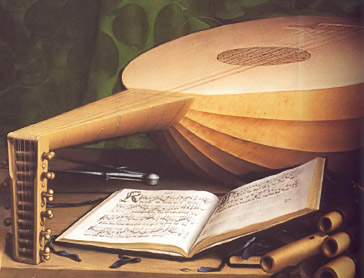
LUTE CAMERATA
LEVEL ONE
home
Level one: A good sound. Know what they knew, and practice. Tuning. Simple pieces, basic technique. Beginning notation. Throw away your solo CDs.
Level two: books of songs; simple scores, two clefs. Jack & Joan. Simple pieces and songs from both Tab and keyboard notation. The grand rotation.
Level three: basic singing, basic sight-reading; intermediate musicianship.
Level Four: The art of accompanying. Ensemble skills. Medium to high difficulty part songs.
Level five: the great solos and real renaissance ornaments; complex scores, clefs. Different Tab versions, singing from TAB. Arranging. The art of orchestra playing. Advanced rhythms such as late 14th century music and pieces by Tye and Baldwin.
Level Six: True professional, thorough knowledge of the middle ages, renaissance and baroque. All clefs. Al scores. All solos. All songs.
UNDER CONSTRUCTION Pages to finished August 07 |
If you have turned the page, you have the essential Elizabethan quality to progress to the next level--curiosity. You may ask, Dear Reader, why should I learn all this? I'm happy surfing through tab; it's light & fun & easy! The simple answer is that it will open up worlds within worlds of music, and your listening and music making will be forever changed. But much more important than all of this is that we owe it to the lute. We must set the highest standards, so that when musicians see a lute player play, they say. "Those lute players; they are the best musicians." As was surely the case. Another reason is simply that you will play much better. Ultimately, it is the keenness of thought, not the muscles in the fingers, that will take you to a higher level of technique. And this can be easily proved, for many practice daily, and yet all do not have the kind of technique that allows them to play any piece. When I began the study of the lute, the custom of the time was to put this piece in front of a student, and make them learn it. That was lesson one. And here it is. In retrospect, perhaps this is the best way, but musical training today is different from what it was forty years ago. What you see before you is two basic clefs, clefs you need to know (a tiny fraction of what any Elizabethan musician would know). The top clef in both the song part and the lute part is a fancy way of writing the letter G, and for now we will consider that to be the top string of the lute. The bottom clef is a fancy way of writing the letter F, and we start by saying this note is the 4th course of the lute, counting from the floor up, unless you are upside down. Jack & Joan is very simple, you can probably work your way through it in under an hour, which is a very short time indeed, but anyone who wants a free lesson on how to play it need only find me and make an appointment. Once you are comfortable with this song, learn these few simple pieces by reading the two parts in two clefs, This will train your mind and body. Once you have done that, you will be on your way. Next, you must find a new teacher. |